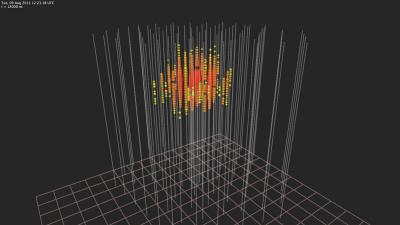BELLINGHAM, Washington, USA -- Scientists at a massive underground particle detector in Antarctica called the IceCube South Pole Neutrino Observatory have detected high-energy neutrinos, ideal for the future of "extreme astronomy" because they can be used to detect the sources of cosmic rays and provide information about our universe's most violent and least-understood phenomena.
"This is the first indication of very high-energy neutrinos coming from outside our solar system," says Francis Halzen in a press release about the discovery. Halzen is the principal scientist at IceCube and a physics professor at University of Wisconsin-Madison, where the IceCube project is headquartered. "It is gratifying to finally see what we have been looking for. This is the dawn of a new age of astronomy."
Because neutrinos are subatomic particles with little mass and no electric charge, their interactions with matter are so weak that they typically pass through Earth without detection, Halzen writes in "Observing high-energy neutrinos with IceCube," an open-access article published 26 November in the SPIE Newsroom.
A majority of the high-energy neutrinos zipping through the universe were produced in collisions around 15 billion years ago, soon after the birth of the universe. Others are constantly being produced from nuclear power stations, particle accelerators, nuclear bombs, atmospheric events, and during the births, collisions, and deaths of stars. About 100 trillion neutrinos pass through our bodies each second.
"They can travel unscathed from the edge of the universe, from the inner neighborhoods of black holes, and from the nuclear furnaces where cosmic rays are thought to be created," Halzen writes.
The $271-million IceCube particle detector transformed a cubic kilometer of Antarctic ice into an array of 5,160 optical sensors on 86 strings that extend 8,000 feet below the ice surface, where the intense pressure provides completely transparent ice. Every so often, a high-energy neutrino passing through Earth collides with a nucleus in the ice, producing electrically charged secondary particles that radiate in a glow of blue light (called Cherenkov radiation).
"Now that we have the full detector we finally have the sensitivity to see these events," Halzen told SPIE.
The radiation spreads through the transparent ice for hundreds of feet, where it can be detected by the IceCube's optical sensors. By mapping the light pool using data collected from May 2010 to May 2012, scientists have discovered the flavor, energy, and arrival direction of more than 28 high-energy neutrino events so far.
Scientists were initially surprised to detect two neutrinos with ultra-high energies in the petaelectronvolt (PeV) range, rather than in the super-exaelectronvolt (EeV) range they expected for cosmogenic neutrinos. This information led them to design a filter for IceCube to exclusively identify neutrinos that interact inside the detector, eliminating issues with atmospheric neutrinos.
"After detecting hundreds of thousands of atmospheric neutrinos, we have finally found something different," says Halzen. "We've been waiting for this for a long time. Now on to the astronomy."

This is a light pool produced in IceCube by a high-energy neutrino. The measured energy is 1.04PeV (petaelectronvolts), which represents a lower limit on the energy of the neutrino that initiated the shower. The vertical white lines represent the IceCube sensors. The color of the dots indicates arrival time, from red (early) to purple (late) following the rainbow. The size of the dots indicates the number of photons detected.
(Photo Credit: Image: Univ. of Wisconsin/SPIE)
Source: SPIE--International Society for Optics and Photonics